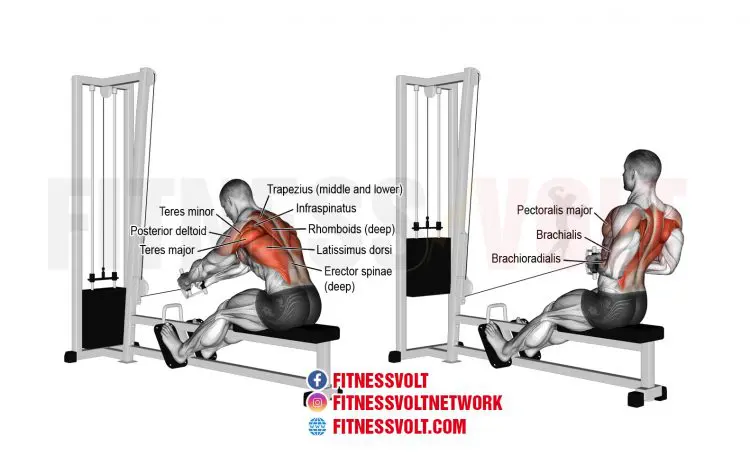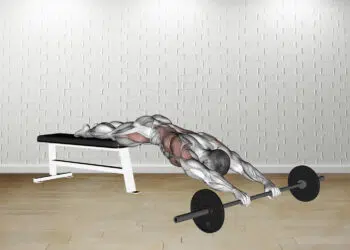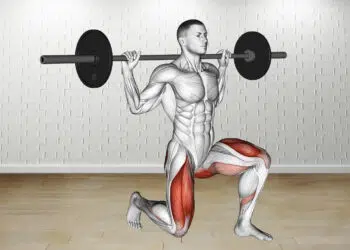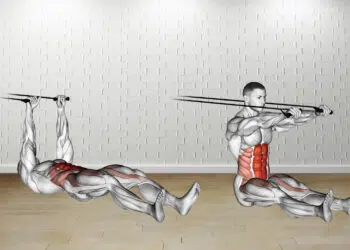The seated cable row is an excellent compound movement for building muscle and strength in your back. It is a beginner-friendly exercise suitable for exercisers of varying training experience.
Unlike dumbbells and barbells, cables and machines keep constant tension on your target muscles throughout the range of motion, which can help promote hypertrophy. Plus, since most dumbbell and barbell back exercises are performed while standing, it leads to core muscle stabilizer recruitment, which can make establishing a mind-muscle connection with your back more challenging.
Performing cable rows while seated on a bench eliminates the role of stabilizer muscles to a great extent, allowing you to focus on your lats. The seated cable row is a godsend for folks who cannot feel their lats engage while performing free weight exercises like the dumbbell or barbell rows.
The seated cable row is a versatile exercise that can be programmed into various workouts. Additionally, you can use different cable attachments in this exercise to change your grip position and train your back from multiple angles to ensure overall growth.
That said, the V-bar seated cable row is the most popular variation of this exercise. It involves holding the bar with a neutral (palms facing inward) grip. This hand placement allows you to keep your elbows close to your sides during the concentric phase of the movement, which helps better engage the lats. Alternatively, you can also use a wide, medium, or narrow, underhand or overhand grip on a straight bar in this exercise.
In this article, we dive deep into the seated cable row to maximize your results. You’ll learn about the correct training technique, muscles worked, common mistakes, benefits, and its best variations and alternatives.
Level Up Your Fitness: Join our 💪 strong community in Fitness Volt Newsletter. Get daily inspiration, expert-backed workouts, nutrition tips, the latest in strength sports, and the support you need to reach your goals. Subscribe for free!
What is a Seated Cable Row?
The seated cable row is a back exercise that primarily targets the latissimus dorsi. It also trains the other upper back muscles, such as the rhomboids, traps, and posterior deltoids. You can put more emphasis on these muscles by changing your grip.
The seated cable row has been a staple in bodybuilding routines since time immemorial. In one of the most iconic training scenes from the cult-classic bodybuilding documentary Pumping Iron (1977), Arnold Schwarzenegger is seen performing a heavy set of seated cable rows.
At this point, I must address the elephant in the room — the use of excessive leverage. Many lifters let their egos get the better of them while performing this exercise and stack more weight on the cable than they can lift with the correct form.
You should not lean forward too much at the bottom of the movement or lean back excessively at the top. Try to keep your torso as upright as possible through the motion. Using momentum by swinging your torso back and forth removes tension from your target muscles and puts it on your secondary muscle groups.
You must perform this exercise with a picture-perfect form to get the best bang for your buck and reduce your risk of injury.
How To Do Seated Cable Row
Since the V-handle bar row is the most popular variation of the seated cable row, I’ll use it as an example for this tutorial. Here is a step-by-step guide on how to perform the seated cable row:
Step 1 — Take Your Position on the Bench
Pin an appropriate weight on the stack. Sit on the rowing machine’s bench facing the pulley so that you can comfortably reach the V-bar handle. Lean forward and grab the handle with a neutral grip. Place your feet on the footrest. Your knees will likely be bent at this position, and your lower legs will be at 45 degrees. Sit upright on the bench. Your elbows should be just shy of lockout.
Pro Tip: Start on the right foot by selecting a weight you can lift using the correct form for eight to 12 reps. Choosing a weight that is too heavy for you will make following through with the other form tips more difficult.
Step 2 — Engage the Weight
Brace your core and get into the starting position by extending your knees and moving away from the pulley. The weight will be engaged at this position. Keep your back and neck neutral through the range of motion.
Pro Tip: Avoid locking out your knees while performing this exercise, as it can make cycling through the reps more awkward and will put unnecessary stress on your lower back.
Step 3 — Lean Forward
Unlike most back exercises where the first phase of the movement is concentric, the seated cable row starts with an eccentric motion. Use the lowering motion to feel your latissimus dorsi muscles engage and take in a deep breath.
Although many trainers advise against leaning forward while performing the seated cable row, it is not necessarily a bad thing. However, you must ensure your torso doesn’t break 45 degrees on the eccentrics.
The weight should not hit the stack at the bottom of the range of movement, as it will remove tension from your working muscles. You might want to readjust your position and sit back a little farther away from the pulley if the weight is disengaged at the movement’s bottom.
Pro Tip: Avoid rounding your back or overextending your spine while performing this exercise. It will take away the tension from your lats and put it on your spine.
Step 4 — Row!
Drive your legs into the footrest to engage your lower body. Extend your hips to return your torso to the upright position while pulling the bar to your belly button by driving through your elbows. Keep your elbows close to your body for optimal latissimus dorsi engagement, and pull your shoulder blades back and down.
Your elbows should be behind your midline at the static contraction point at the top. Pause and contract your lats at this position. Avoid flaring your elbows as it will remove tension from your lats and put it on other upper back muscles like the traps, rhomboids, and posterior deltoids. Repeat for recommended reps.
Pro Tip: Your torso should not lean back more than 100 degrees at the top of the motion. Keep your shoulder blades pulled back and down and your chest proud for maximal lat engagement.
Watch our training coach Enrique Santatecla demonstrate the correct seated cable row below:
Seated Cable Row Tips:
- Most lifters experience biceps and forearm recruitment while performing the seated cable row. You can limit your arm engagement by using a false (thumbless) grip or weightlifting straps.
- Focus on keeping the cable parallel to the floor while performing this exercise. Pulling at an angle toward your chest will lead to great shoulder and upper-back muscle stimulation.
- Although you are allowed to lean forward and back while cycling reps, you shouldn’t use it as leverage. Using momentum can put excessive stress on your lower back.
- Use a straight bar attachment and grab it with a wide overhand grip and flare your elbows during the concentrics to engage your other upper back muscles. On the other hand, employ an underhand grip while keeping your elbows close to your sides to bias your lower lats and biceps.
- Keep your feet shoulder-width apart on the footrest. Using a wide stance will lead to adductor engagement while performing the exercise.
Muscles Worked During Seated Cable Row
The seated cable row is a compound exercise that targets multiple muscle groups. Here are the muscles that gain to benefit from this lift:
Latissimus Dorsi
Latissimus dorsi, popularly known as the lats, are the primary target muscle of the seated cable row. Developed lats can add width to your frame and give you the coveted cobra back. A V-taper can improve your physique’s aesthetics by making your shoulders look wider and your waist tighter.
You must focus on driving through your elbows and keeping them close to your side while performing this exercise for optimal lat engagement. Your upper arms should at least be at your torso’s midline at the static contraction point at the top for maximal latissimus dorsi muscle fiber recruitment.
Consider slowing down your rep tempo if you don’t feel your lats fire up while performing this exercise. Folks that go too heavy on this exercise and fail to use a full range of motion also tend to experience suboptimal latissimus dorsi stimulation.
Upper Back
Besides the latissimus dorsi, the seated cable curl will train your upper back muscles, including traps, rhomboids, teres major and minor, and posterior deltoids. Although developed lats will add width to your frame, you need dense upper back muscles for better aesthetics.
However, you will need to adjust your form to switch your focus from the lats to other upper back muscles. Instead of keeping your elbows close to your sides, you must flare them during concentrics. For better upper back stimulation, your upper arms should be in line during the upward motion. Furthermore, you’ll have to trade the V-handle bar with a straight bar and hold it with a wide overhand grip.
Depending on your height, you might have to tweak your angle of pull to focus on your upper back musculature. Taller individuals should pull the bar to the bottom of their rib cage to bias their traps, rhomboids, and rear deltoids.
Biceps
Most pulling exercise lead to biceps engagement. The heavier you lift, the greater the demand on your biceps and forearms will be. Using a neutral grip on this exercise will work the brachialis muscle, which can add thickness to your arms. An underhand grip will train your biceps brachii muscles, whereas an overhand grip will stimulate the brachioradialis.
You can limit your biceps engagement in this exercise by using a false grip. Alternatively, you can use lifting straps to reduce the demand on your pythons. Another trick to limit your biceps from taking over this exercise is to focus on driving through your elbows.
Folks that rely on their arms to move the weight end up using their biceps. Think of your hands as hooks while performing the seated cable row, and lift the weights by driving your elbows behind your body.
Shoulders
Since the seated cable row involves movement at the shoulder joint, you will experience deltoid engagement while performing this exercise. This exercise leads to posterior deltoid engagement during eccentrics and anterior deltoid stimulation on concentrics.
The more you pull your upper arms behind your midline during concentrics, the greater the front delt engagement will be. Alternatively, you can limit your shoulder engagement in this exercise by limiting your range of motion. However, this is not recommended.
Following an extended range of motion while performing this exercise, especially on eccentrics, might lead to excessive lower back engagement; however, you will never hear anyone complain about too much shoulder activation while performing the seated cable row.
Benefits of Seated Cable Row
Here are the advantages of adding the seated cable row to your exercise regimen:
Level Up Your Fitness: Join our 💪 strong community in Fitness Volt Newsletter. Get daily inspiration, expert-backed workouts, nutrition tips, the latest in strength sports, and the support you need to reach your goals. Subscribe for free!
Build Muscle Mass and Strength
The seated cable row is a go-to in many pro bodybuilders’ routines for building a bigger and stronger back. Lifters with the goal of building muscle mass should perform three to five sets of eight to 12 reps of this exercise with 60 to 80 percent of their one-rep max (1RM). On the other hand, folks training for strength gains should do three to six sets of one to five repetitions with 80 to 100 percent of their 1RM. [1]
You must employ the progressive overload principle in your workouts to ensure consistent gains. Following the same training split for an extended period can lead to strength and muscle plateaus.
Keep Constant Tension on Your Back
Unlike dumbbell and barbell exercises, cables keep constant tension on your back throughout the range of motion. Plus, they enable training your lats in the transverse plane while seated upright, which is virtually impossible with free weights.
Cables and machines are also much safer than free weights. It is the reason why you hardly hear of people getting injured on machines or cable pulleys. Many professional bodybuilders switch to machine-only workouts while prepping for a show to limit their odds of getting hurt while training.
Improves Posture
Folks that spend most of their days hunched over a computer or smartphone end up with poor posture. Back exercises that work the upper posterior muscles throughout their full range of motion can help undo some of this damage.
Common Mistakes While Performing Seated Cable Row
You must avoid the following training technique errors to ensure you are not leaving gains on the table:
Limited Range of Motion
With all the disinformation about the ideal range of motion of the seated cable row, most people tend to play it safe and follow a restricted ROM. While there is nothing wrong with keeping your torso locked at 90 degrees while performing this exercise, you should know that you are selling yourself short by not leaning forward and taking your back through a more extended range of motion.
No Control on the Eccentrics
The last point is a perfect segue into this one. Although I encourage you to lean forward slightly during the lowering motion, you shouldn’t let the weights do the work for you. You must be in total control of the weight during eccentrics.
You must contract your lats and feel the muscle fiber engage during the negatives. On the flip side, if you have no control over the weight in the eccentric phase, it is a sign that you are going a little too heavy.
Leaning Forward Too Much
A little body English is acceptable. However, your arms should not be in an overhead position, and your torso shouldn’t be almost parallel to the floor at the bottom of the range of movement. Leaning forward too much leads to a rounding of your back, which makes you more susceptible to injury.
Going Too Heavy
After the leg press, the seated cable row machine is arguably the most abused training equipment in the gym. Many lifters stack more weight on the machine than they can handle, moving it a few millimeters with lousy form. This does more harm than good. If you cannot move the weight through a full range of motion, you should end your set and try again with a lighter weight.
Variations of Seated Cable Row
Exercise variations can be a great way to keep your workouts from going stale and ensure overall development by training your muscles from different angles. Variations and alternatives can also help you break through muscle and strength plateaus.
These are the best seated cable row variations that should be a part of your exercise arsenal:
Controlled Eccentrics
Love the seated cable row but have not been getting a pump lately? You should try switching up your rep tempo. Most people follow a 1-1-1-1 rep tempo on the seated cable row, meaning they spend one second on eccentrics, pause for a second at the bottom, take a second on the concentric phase, and hold the contraction at the top for a second.
Change your rep tempo to 3-1-1-2 to shock your system. Here, you’ll spend three seconds on eccentrics, hold for a second at the bottom, take one second on eccentrics, and pause and squeeze your lats at the top for two seconds.
According to a Br J Sports Med study, “eccentric training performed at high intensities was shown to be more effective in promoting increases in muscle mass measured as muscle girth” than concentric training. [2]
However, you must be patient while incorporating eccentric-focused training into your training. Stick to a rep tempo for at least a couple of weeks to get the best results. Switching rep tempos in every workout doesn’t allow your muscles enough time to adapt to your training regimen.
Single-Arm Seated Cable Row
This is a unilateral variation of the seated cable row. Since unilateral exercises involve training one side of your body at a time, they are incredibly effective at fixing strength and muscle imbalances. [3]
You must switch the V-handle bar with a D-handle, as you’ll be using one limb for this seated cable row variation. Although the setup for this variation is similar to the conventional cable row, here are a few crucial adjustments that you must make to get the most out of this exercise:
- Start with almost 50 percent of your standard seated cable row weight on this exercise.
- Keep your shoulders square while performing this exercise, and avoid pulling your working side behind the non-working on concentrics.
- Place your non-working arm on the thigh of the same side for stability.
- Rotate your wrists anti-clockwise during concentrics for better latissimus dorsi engagement.
- Lean forward with both shoulders during eccentrics. Avoid overextending your working side toward the pulley. Remember, your shoulders must work as a single unit.
Cable Row on a Pulley
Folks that don’t have access to a seated cable row machine need not hang their heads low. This exercise is just as good on a cable pulley machine. Here is how to perform this exercise on a cable pulley or functional trainer for the best results:
- Set the pulley at the lowest setting. Clip a V-handle bar attachment to the pulley.
- Set an aerobic step in the center of the cable pulley machine. You could perform this exercise while seated on the floor but using an elevated surface helps you maintain an upright back during concentrics.
- Grab the V-handle bar and sit on the aerobic step.
- Place your feet flat wider-than shoulder-width apart on the floor. There should be enough space between your legs for your shoulders to pass through.
- Lower the bar toward the pulley. This will be your starting position.
- Extend your hips and pull your torso backward while bringing the V-handle to your belly button.
- Rinse and repeat.
Alternatives of Seated Cable Row
Here are the best seated cable row substitutes:
Resistance Band Seated Cable Row
This exercise is excellent for folks that train in their garage gym and don’t have access to a cable pulley. Furthermore, it can be used by beginners to drill the movement or people undergoing habilitation.
How To:
- Sit on the floor with your legs extended and place your feet together.
- Wrap one end of a loop resistance band around your right hand and the other around your left.
- Position the center of the band under your midfoot.
- Sit upright with your arms extended in front of you.
- The band should be taut at this position. Grab the resistance band close to your feet if there is slack in the band.
- Bring your hands to your sides while driving through your elbows.
- Pause and contract your lats at the top.
- Slowly return to the starting position.
- Repeat for recommended reps.
Pro Tip: Some people find tying the band around their feet uncomfortable and unstable. You can use a door anchor to perform this exercise if you are one of them. Alternatively, you could tie one end of the resistance band around a sturdy object like a squat rack pole.
Barbell Row
The barbell row is a staple in most back workouts for a reason — it works! Bodybuilding legends and Mr. Olympia champs like Ronnie Coleman, Dorian Yates, and Lee Haney relied on this exercise to build a thick, wide back. There is no reason why you shouldn’t too.
How To:
- Stand upright with a hip-width stance while holding a barbell with a double overhand shoulder-wide grip against your thighs.
- Lean forward by bending at your hips so your torso is at 45 degrees. Lower the bar until it is at knee level.
- Brace your core and lift the bar to your belly button while driving through your elbows.
- Pause and contract your lats at the top of the movement.
- Slowly lower to the starting position.
- Repeat for recommended reps.
Pro Tip: Switch to an underhand grip to work the lower lats. Avoid using momentum by swinging your torso up and down, as it will remove tension from your lats and put it on your biceps and shoulders.
Check out our complete barbell row guide here!
Smith Machine Barbell Row
Since the Smith machine barbell works along fixed rails, many lifters favor it over the conventional barbell row. The fixed movement trajectory of the bar eliminates the role of core stabilizers, allowing you to focus on your lats.
How To:
- Add an appropriate weight to the Smith machine barbell.
- Unrack the bar and let it rest at the bottom of the rails.
- Bend over and grab the bar with a shoulder-wide overhand grip.
- Keeping your torso at 45 degrees, pull the bar to the bottom of your rib cage.
- Pause and squeeze your lats at the top.
- Slowly return to the starting position.
- Repeat for recommended reps.
Pro Tip: Perform this exercise while standing on the side of the barbell where the latches are disengaged. Standing on the other side can lead to unintentional racking during your set.
Chest-Supported T-Bar Row
This exercise is incredibly effective for folks that have difficulty maintaining their torso at 45 degrees while performing the barbell row. Since you’ll be resting your chest on a pad during this exercise, you can focus your energies on following a full range of motion and contracting your lats with each rep.
How To:
- Place the center of your chest on the machine’s pad center and your feet in a steady position.
- Grab the bar with a pronated grip.
- Unrack the bar and hold it at arm’s length.
- Lift the bar toward your chest by driving your elbows out and to your sides.
- Pause and contract your upper back muscles at the top.
- Slowly return to the starting position.
- Rinse and repeat.
Pro Tip: Most lifters overlook their foot placement while performing this exercise. You can generate considerable power on this exercise with correct foot placement. Your feet should be flat on the floor or the footrest, and you must drive through your whole feet during concentrics.
FAQs
Why do I feel lower back pain while performing the seated cable row?
Rounding your back during the eccentric phase of the lift is the most popular reason for lower back pain during the seated cable row. While it is okay to lean forward during the lowering motion, your torso should not break 45 degrees, as it puts your lower back in a vulnerable position, especially if you have heavy loads on the pulley.
Keep your back neutral throughout the range of motion to avoid stressing your lower back. Even when leaning back slightly at the top of the motion, ensure you don’t overextend your spine.
Can I replace the barbell row with the seated cable row?
The barbell row and seated cable row are both compound exercises. However, the former requires you to remain bent over, which engages your core stabilizer, whereas there is constant tension on your back throughout the range of motion on the latter.
Both exercisers offer unique benefits, and you must not choose one over the other. Many experienced lifters perform both movements in the same workout to bias hypertrophy and build strength.
Can I substitute pull-ups with seated cable rows in my workout?
Back workouts designed for hypertrophy consist of two types of movements — overhead vertical pulling and horizontal rowing. Overhead pulling exercises such as pull-ups and lat pulldowns help build back width. On the other hand, horizontal pulling exercises such as the seated cable row and barbell bent-over row help build back thickness.
You need both types of movements to ensure overall back development. To answer the question, no, you should not replace pull-ups with seated cable rows. In fact, pull-ups are one of the most effective exercises to build back width and upper body strength.
Wrapping Up
The seated cable row is an incredibly potent exercise to build back thickness and definition. Keeping your elbows close to your sides while performing this lift can help you achieve the coveted ‘Christmas tree.’
This seated cable row exercise guide covers all the details you need to know to ensure you don’t leave any gains on the table. Lastly, use the exercise variations and alternatives listed above for overall back development. Best of luck!
References
- Schoenfeld BJ, Grgic J, Van Every DW, Plotkin DL. Loading Recommendations for Muscle Strength, Hypertrophy, and Local Endurance: A Re-Examination of the Repetition Continuum. Sports (Basel). 2021 Feb 22;9(2):32. doi: 10.3390/sports9020032. PMID: 33671664; PMCID: PMC7927075.
- Roig M, O’Brien K, Kirk G, Murray R, McKinnon P, Shadgan B, Reid WD. The effects of eccentric versus concentric resistance training on muscle strength and mass in healthy adults: a systematic review with meta-analysis. Br J Sports Med. 2009 Aug;43(8):556-68. doi: 10.1136/bjsm.2008.051417. Epub 2008 Nov 3. PMID: 18981046.
- Andrushko JW, Lanovaz JL, Björkman KM, Kontulainen SA, Farthing JP. Unilateral strength training leads to muscle-specific sparing effects during opposite homologous limb immobilization. J Appl Physiol (1985). 2018 Apr 1;124(4):866-876. doi: 10.1152/japplphysiol.00971.2017. Epub 2017 Dec 14. PMID: 29357520; PMCID: PMC5972467.
Interested in measuring your progress? Check out our strength standards for Pull Ups, T Bar Row, Seated Cable Row, and more.









